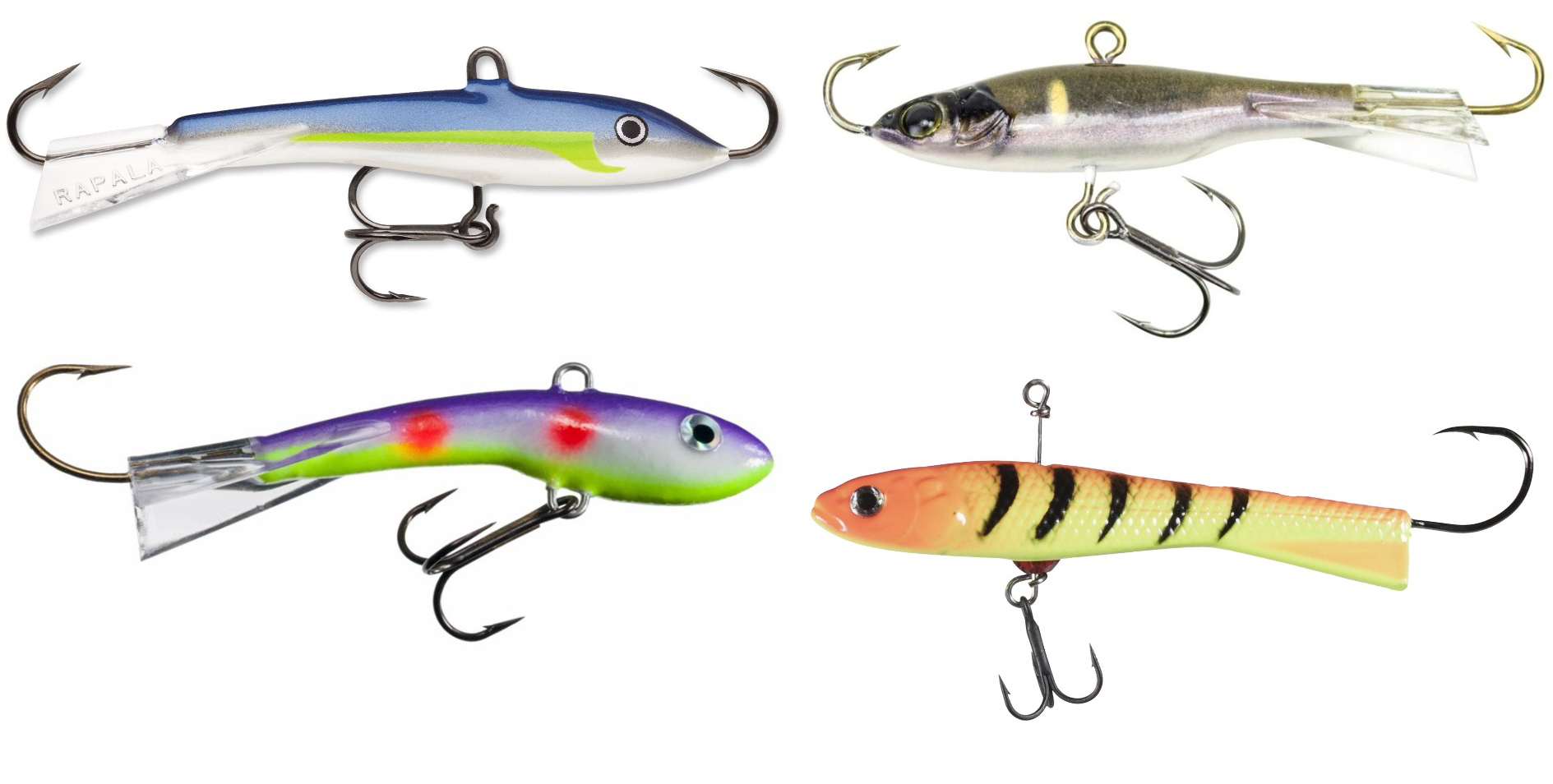Double Duty
The jigging minnow isn’t just for ice fishing anymore
Advertisement
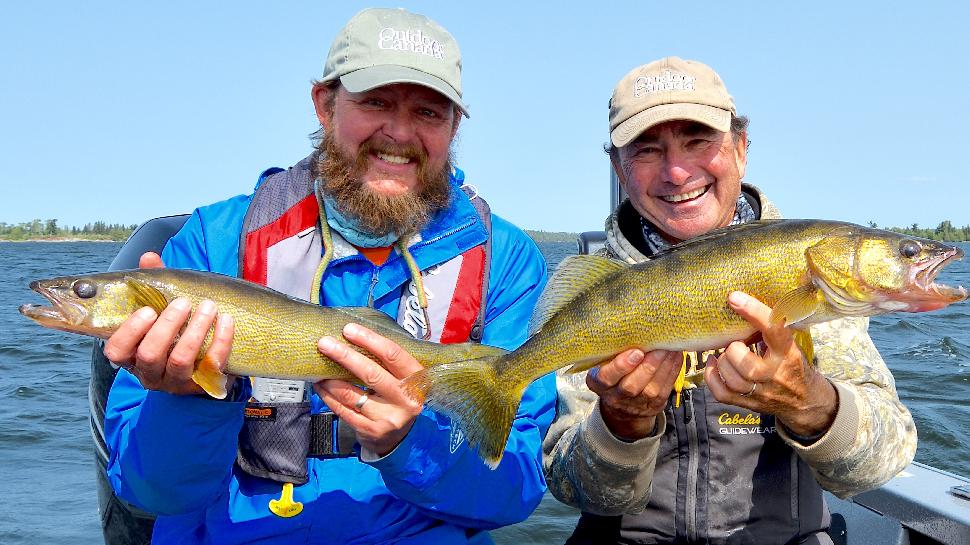
I bet every winter walleye angler in the country has a stash of jigging minnows, typified by Rapala’s iconic Jigging Rap, as their go-to ice-fishing lures, and for good reason: they flat out catch fish. They work so well, in fact, that in-the-know guides and tournament pros have even started using these heavy hardwater baits to whack walleye during the open-water season.
While the Jigging Rap was the first such jigging minnow, it’s now surrounded by a bevy of similar lures, including Lunkerhunt’s Straight Up Jigs, Moonshine Lures’ Shiver Minnow, Acme’s Hyper-Glide, Northland Tackle’s Puppet Minnow and Freedom Tackle’s Turn Back Shad. Whatever model you choose, if you present it properly at the right time and in the right place, you won’t find a better way to put walleye in the livewell—from ice-out in early spring to ice-up in late fall.
Advertisement
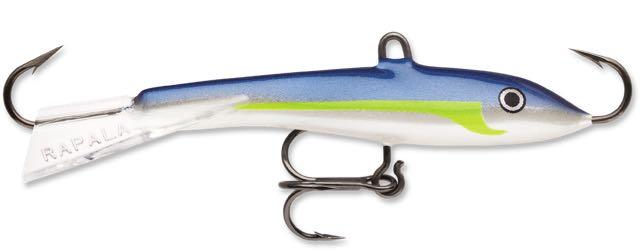
Location and Timing
Flats are key when it comes to fishing with jigging minnows in open water, especially flats consisting of sand, gravel, mud and detritus. Weeds can be a bonus, although they’re not a necessity. Rocks and wood, on the other hand, are a definite hindrance—if there’s one knock against these lures, it’s that they snag easily because of their shape, weight and hook configuration.
Having said that, some of the biggest walleye tournaments have been won by anglers who simply refused to put down what was working so well, cycling through three dozen or more jigging minnows on their way to victory. Still, my favourite locations are on large, relatively barren sand, mud and pea-gravel flats, typically in 20 to 30 feet of water, stretching 100 to 200 yards from shore before dropping down a moderate slope to deeper water.
Schools of walleye will travel along the edges of such flats, using them as highways paralleling shore. Indeed, if you troll slowly along one of the edges and study your sonar screen, you’ll typically find finger-like indentations the fish use as stairs to swim up onto the flat to feed, as well as to return to the basin when wind, bad weather or fishing pressure drives them away. The flats are where you want to be snapping the lures as you slowly move along, while the notches and grooves are the sweet, high-percentage spots-on-the-spot when it comes time to cast.
Advertisement
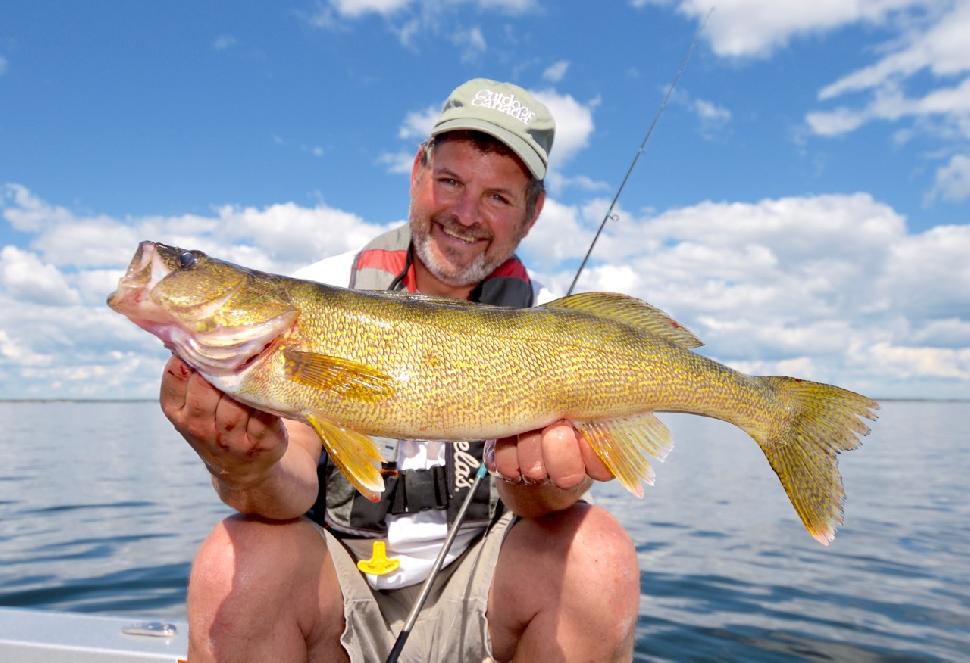
Walleye also love the muddy, silty, black-bottomed bays immediately adjacent to the areas where they spawned in the spring. As soon as they complete the egg-laying process, walleye will take up residence in any of these nearby shallow bays as long as they have warm, hospitable water and food in the form of yellow perch. It’s even better if you can find a cove with lush cabbage weeds emerging in the back end, or a blanket of green chara (a.k.a. sand grass) growing on the bottom.
If you’re not familiar with chara, you’re missing out on what I consider to be a walleye bonanza. Remember Chia Pets, those clay pottery animals that sprouted green hair when you added water? That’s what chara looks like. It smells skunky when you roll it between your fingers, and it only grows a few inches tall, but walleye absolutely love swimming above bottoms blanketed in it. Chara is so strongly associated with the type of bottom that walleye and yellow perch adore, I get excited whenever I find a piece snagged on my hook.
Advertisement
Another prime time to fish a jigging minnow is when the mayflies start hatching in late June and early July, and you see their cases and carcasses floating on the surface of your favourite lake, river, reservoir, pit or pond. Ironically, that’s the same time many walleye anglers will tell you the fish have gone into a feeding funk. But trust me, the opposite is the case—the walleye are feeding so heavily on the mayfly larvae crawling along the soft bottom that they’ll even stop biting live minnows dropped on their noses.
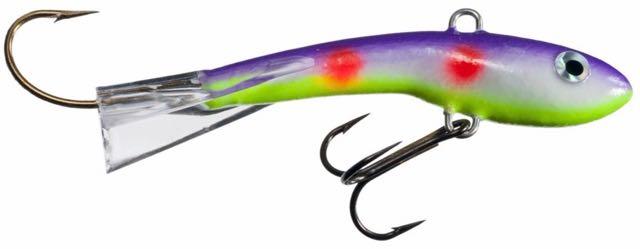
While savvy anglers have discovered the effectiveness of the now popular slow-death method for catching these ill-tempered fish, ripping a jigging minnow is even better on many days. And the reason is perhaps the most critical part of the lure’s open-water success story—walleye hit the lure because it makes them angry, not because they’re hungry. That’s why you never have to worry about tipping the bottom treblehook with a minnow head or soft-plastic dressing, as you typically do in the winter. Instead, it’s all about getting the fish to lash out and snap at your bait.
Trolling, Strolling and Casting
Another benefit of jigging minnows is that their short, compact, dense construction allows them to sink like a stone. This is usually not helpful with other baits, but with jigging minnows, it enables you to precisely control the depth and speed of the lure. I can think of few other baits that excel the way jigging minnows do in 20 to 40 feet of water—and in strong winds and heavy current—as you stroll, troll and cast.
Strolling is a combination of casting and trolling, where you flick your lure back a short distance behind the boat, then use the front bow-mount electric trolling motor to move you forward. While these jigging minnows allow you to be in charge of their depth and speed, you can’t control their action under the water. Once you cast one behind the boat and start moving, or begin winding it back to the boat, there’s little you can do to screw up its random, walleye-enticing qualities.
So, how do you best present a jigging minnow? I always start by slowly criss-crossing a flat that I suspect is harbouring fish while keeping a close eye on my sonar screen. I set my Humminbird Helix 12 on split-screen, with one side set on traditional 2D sonar and the other on Down Imaging. The second unit on my console is always plotting my course.
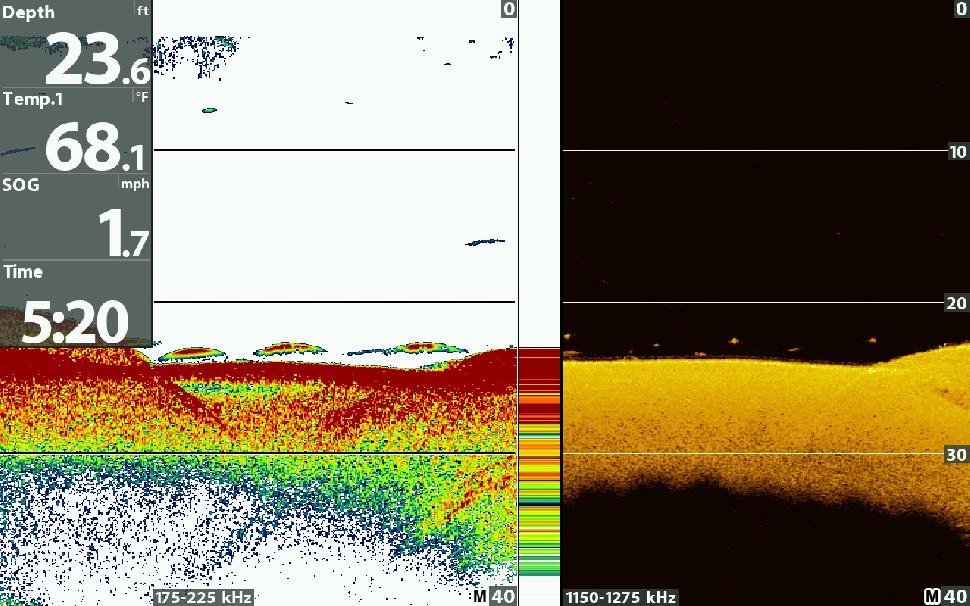
While I’m searching for walleye, any time I detect one of those finger-like indentations, I hit the waypoint button and save the location for future reference. The same goes for every ball of bait I pass over. I also pay close attention to how high up off the bottom the walleye are suspended. Fish that are floating up several feet are likely to be more aggressive than bottom-huggers.
This information is important, as it determines the size of the jigging minnow I select and the speed at which I’m going to present it. For the bottom-huggers, I pick a slightly smaller two-inch, 5/16-ounce lure and troll at a slightly slower pace of three-quarters of a mile per hour. When I see the high flyers, on the other hand, I choose a bigger 2¾-inch, 5/8-ounce lure, and you can be sure I’ll have an even larger 3½-inch, 7/8-ounce jigging minnow warming up in the bull pen. And I’m going to start trolling with my electric set at one mile per hour (see “Trolling tricks” below). The differences may sound subtle, but they’re significant.
When strolling these baits, I’m mindful to cast the lure behind the boat so that the angle between my rod tip and lure is roughly between 45 and 50 degrees. It’s important not to let out so much line that the angle droops lower than this, or you’ll be dragging the lure, not hopping it off the bottom. So, choose your lure weight and adjust the speed of the boat accordingly.
When you get it right, you’ll have the bait hopping off the bottom and falling randomly back down on controlled slack line. The action you’re trying to impart is not unlike the side-to-side, walk-the-dog motion of a topwater stickbait when fishing for bass. Just be sure you don’t have a tight line, which will impede the action of the lure as it falls back to the bottom. The lure doesn’t have to hit the bottom on every rip, but often enough that the fish can streak after it and pin it to the bottom when it touches down.
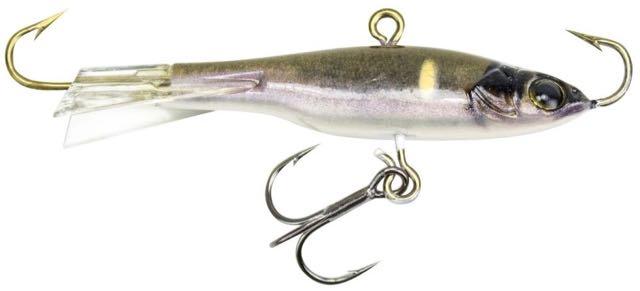
Also take visibility into account. On my home waters of Lake of the Woods in northwestern Ontario, for example, the water is dingy and heavily stained with algae during the summer, so I don’t rip the lure quite as aggressively as I might when I’m fishing a lake with much clearer water. That’s because I want to give the walleye time to see it and react. Developing a confident cadence for the situation at hand makes a significant difference.
I probably troll and stroll swimming jigs 75 per cent of the time, and cast for the remainder, usually when I spot an isolated, bunched up, immobile school of walleye. When you cast, you want to impart the same action to the lure as when you troll. Just don’t get lazy and position the boat in shallow water and try sweeping the lure up from deeper water. If you do, you’ll snag the bottom. Instead, set a waypoint on the pod of fish or mark them with a buoy, then place your boat off the side of the structure in deeper water. That way, you’ll be retrieving the lure down into the deeper water, avoiding snags.
Rigging and Hooksetting
If you’ve never used a jigging minnow in open water before, three things will surprise you. For starters, you likely won’t feel it when a walleye hits the bait. After you sweep up the lure and let it plummet back to the bottom, that’s when a fish will typically pin it to the bottom. So, when you sweep the lure back up to repeat the process, the fish will be on.
With this in mind, I spool my reels with a quality 10- to 17-pound-test, gel-spun super-line. It’s very sensitive, and its non-stretch qualities make for fast hooksets. I always add 18 to 24 inches of a similar-strength monofilament or fluorocarbon leader to my main line using back-to-back uni-knots. I’m usually too quick on the draw, so I think the slightly stretchy leader absorbs a little bit of the shock.
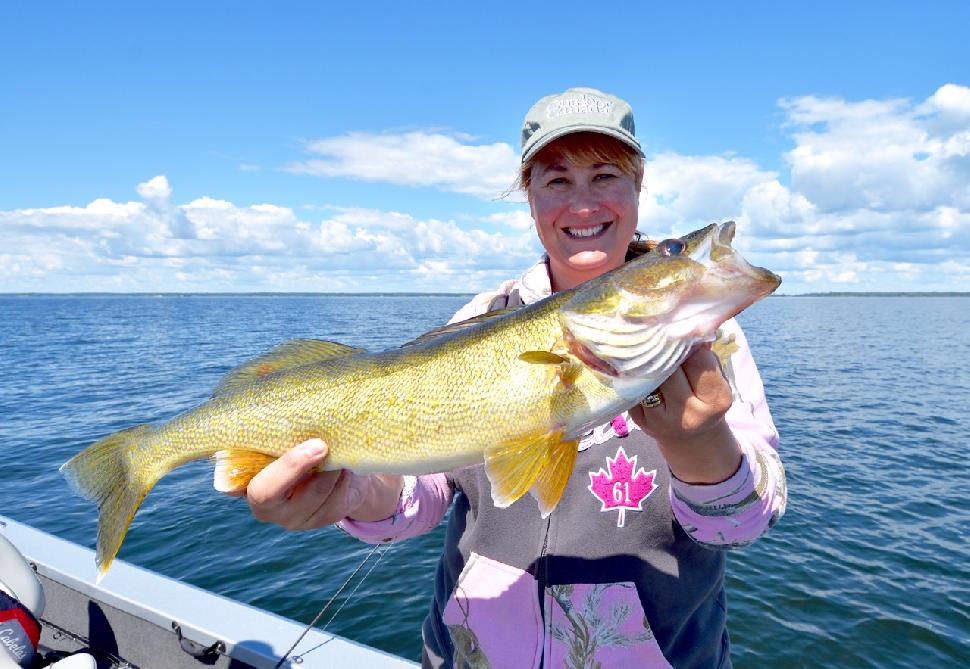
The second thing that will surprise you is the number of walleye you’ll hook above, below and around—but not necessarily in—the fish’s mouth. That’s a clear indication they’re swiping at the bait out of anger as soon as it hits the bottom. For this reason, I use a six-foot eight-inch, medium-action spinning rod with a slightly parabolic tip, which perfectly complements my super-line and leader preferences.
You’ll also substantially increase the number of walleye you land by replacing the factory treblehook with one that’s one size larger, and opening up each of the three hooks by about five degrees. Note that the hook hangers on jigging minnows are extremely fragile, so to avoid snapping them, you need to bend them ever so slightly to the side in order to change the hooks.
And the third surprise? Because so many walleye will slap, smack, swipe and lash out at your lure as they pin it to the bottom, you’ll find the hooks frequently fall out of the fish when you net them. That’s another good reason for picking a slightly lighter, parabolic-tipped rod. You must also keep tension on your line throughout the fight, and not hurry the fish into the net.
And right in the net is where you’re going to find plenty of big walleye this open-water season—once you try fishing with a jigging minnow.
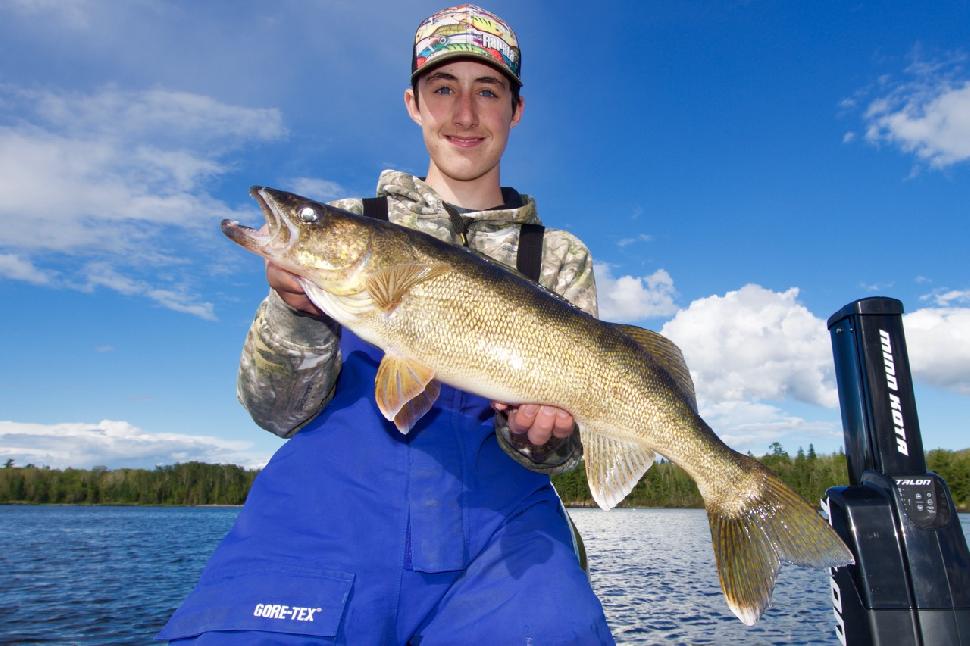
Bonus Tip: Trolling Tricks
I have my Minn Kota Ultrex electric trolling motor linked via an Ethernet cable to the Humminbird Helix chartplotter on my console, enabling me to troll or stroll between waypoints while the iTracks and Cruise Control functions take care of the driving. And if I spot a tightly grouped school of walleye along the way, I simply hit the Spot-Lock feature to hold the boat in place while I cast to the fish. All of this lets me control the boat as though it were a spacecraft docking onto the International Space Station. NASA would be proud of me.

